1400 miles. 17 days. 1 boat. 4 crew. So hard to describe, but I will try……..
Day 1
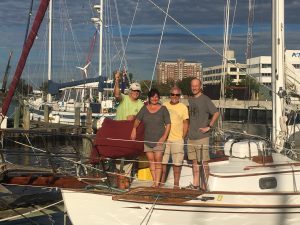
Crew
We had a proper send off mid morning at Gary & Greta’s dock in Norfolk. Everyone was there to wave us off as we headed out. The ride out of Norfolk was much faster than the ride in, with a steady current in our favor. As we passed Hampton, we were soon joined by other boats as the Salty Dawg Rally was leaving the same day. Boats were generally split into two categories: Those that were heading south and then east, or those that were heading east and then south. We were in the latter category – pushing to get across the gulf stream as quickly as possible and also avoiding some stormy weather that was moving up the coast.
We had quite the array of sealife that first day. The usual pelicans were everywhere. Dolphins came out to swim alongside the boat. And at one point we even saw whales!
The only downside was the motoring, which we did for the first 24 hours. We knew it was a risk we faced and pretty much everyone was facing the same issue – motoring and looking for wind further off shore.
Dinner: soup and leftover focaccia
Day 2
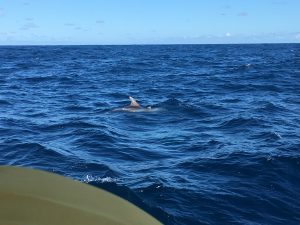
Dolphins
More dolphins at sunrise, this time playing all along the bow of the boat and racing us (guess who won). We were finally able to sail a bit as we headed into the gulf stream. You know you’re in the stream because the water becomes this deep indigo blue – a color I’ve never seen anywhere else in my life.
Now that cell phones were truly out of range I began playing with the InReach device and I was happy to report that everything was working as planned. I had tracking points set to mark our progress every 2 hours and planned on sending a daily one or two lines to update family/friends as needed.
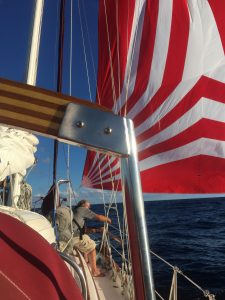
Short lived spinnaker hoist
As the winds shifted we tried to put up the spinnaker, but that only lasted for 5 minutes before we went back to the main and jib. That poor spinnaker saw less than 5 minutes action in the last 5 months.
Dinner: pesto tortellini with peppers, onions & kielbasa; freshly baked chocolate macadamia nut cookies
Days 3-4
Damn Gulf Stream just doesn’t want to let us go, grrrrrrr. We’re barely making 3 knots whether under sail or under motor, it’s really rather frustrating. Crossing the stream is an art form and though we’ve done it well on the Bermuda runs, this time it seems to be striking back a bit. To add insult to injury there’s no animals to keep us distracted today. Trip is listening into the Salty Dawg Rally SSB net so we know there’s a few other boat within 20 miles of us.
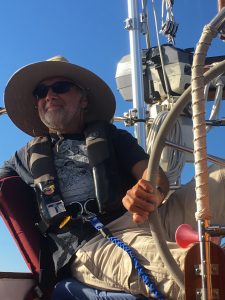 One plus side to the trip is that Trip is finally letting us use the auto helm. Normally a stickler for steering by hand, we started using it more this summer when we were motoring. I started using it for everything on this sail and he hasn’t protested.
One plus side to the trip is that Trip is finally letting us use the auto helm. Normally a stickler for steering by hand, we started using it more this summer when we were motoring. I started using it for everything on this sail and he hasn’t protested.
At dawn, however, we noticed something was up with the autohelm – the drivestop would hit it’s limit, an alarm would sound, and the autohelm would turn off. There were all sorts of possibilities as to what was going on, but the worst case scenario was that we had lost control of the rudder, which would have been very, very bad. We put the emergency tiller in place in case something was up with the wheel. While Trip descended below to investigate, I began to imagine the worst – having to call the Coast Guard for pickup, determining what essentials I’d take with me, etc. The good news is that Trip was able to perform the repair while underway – the arm on the autohelm had slipped and was prematurely stopping the rudder from moving further over. Disaster averted, whew.
I hadn’t been paying attention to the InReach and it rebooted at some point. What I didn’t check was that our tracking points had stopped. Poor Viviane had to send me a note to start them up again. And the jokes began about how we would describe 24 hours of blank space on the map. Alien abduction? Pirate evasion tactics? Our minds ran wild.
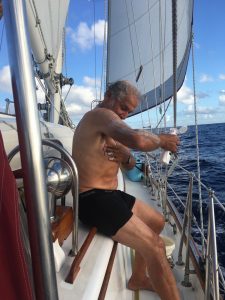
Showers on deck
Knowing our own situation and listening to the SSB nets, everyone doing this cruise was soon going to be facing a fuel issue. Some boats were heading to Bermuda to refuel. We had to keep heading east, so we would keep Bermuda as a possibility, but the general intent was to sail, no matter how long it took. We’re a smaller boat than most doing the run (37 feet compared to 45 and up) which means we carry less diesel (55 gallons for this trip), have a smaller engine (get 5 knots an hour compared to 7 plus). But we have sails and it’s a sailing trip, so we were committed to making it work even if it meant more time at a slower pace. After doing some rough calculations we decided to limit our motoring, if necessary, to less than 4 hours a day to maintain a reserve to get into St Thomas safely.
We did have a little bit of company with not one but 3 cruise ships passing by. Two of them were Disney cruiselines and you could see Mickey’s prominent image in the smokestacks.
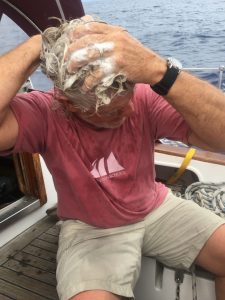
Not quite like the salon, but it works for shampoo & rinse
Things were calm enough that we decided to shower. Nothing feels better than soaping up with saltwater in the cockpit and then doing a freshwater rinse. I know crews in the past would go multiple weeks without showering but there simply was no need. Besides, weather might soon pick up where it wasn’t an option, so why not take advantage of it now?
Dinner: chicken and vegetable stir fry with quinoa & rice
Days 5-7
Lawrence got inspired as he was coming off watch and made a huge batch of scramble eggs with peppers & onions. We had a few whales as visitors again, and despite a forecast of light and variable winds, we were comfortably running 5 knots. We hit our first bit of rain which also came with a lovely rainbow afterward.
And then the autohelm died. It started making strange noises – sounding almost like morse code – before it would error out and die. We consulted the manual but pretty much determined that something that old (original to the boat) had simply led a good life and was toast. I was thrilled that we had even gotten 5 days out of it, since Trip could have just as likely insisted we hand steer instead. Despite this – the next few days would turn out to be the lovliest of the entire trip.

Coffee strong enough to keep anyone awake on watch
We sailed through the night, thus banking 4 hours of fuel to use another day. That evening brought out the most amazing star studded sky and the beginning of shooting stars. It wasn’t uncommon for any one of us to see multiples during the night and this went on for night after night. Dinner: pasta with olives & carmelized onions in tomato sauce
Since conditions were calm enough I decided to give it a shot making bread. Not bad for my first attempt while crossing the high seas – it was a basic sandwich loaf from the NY Times and won’t be the last. We devoured it while Lyle gave his report of sea serpents (Sargasso grass) and mermaids in the local waters. I entertained myself watching the flying fish skimming the surface of the water. Yet another day with no need to motor and hitting 7 knots at times – we could add another 8 hours to the fuel bank. Dinner: leftover pasta with fresh bread
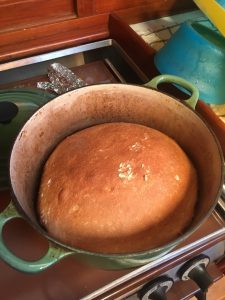
Fresh bread
Just a little bit of bread left over the next morning so I made BLTs for breakfast – not a bad way to start the day. For three days now we have not touched the sails and have been moving comfortably at least 5 knots. It would be heaven if this were the route down to the Virgin Islands, though not likely. The one downside is that because we haven’t run the engine, the batteries are getting low. The solar panels aren’t aimed in the right direction for enough of the day and the wind generator is proving to be crap at generating much power at all – a big disappointment for the overall investment. So we run the engine for an hour or so to top off the batteries. On a sobering note, Trip hears over the Salty Dawg SSB net that a new friend of ours is having to divert to Bermuda because of fuel levels and battery discharge problems. Unfortunately he’s also losing his crew there, so I do hope he’s able to make things work and make it down to Antigua soon.
Things are calm enough that we feature a cocktail hour in the cockpit with everyone, complete with music, between watches. Dinner: Jambalaya with johnny cakes, chocolate pudding
Day 8
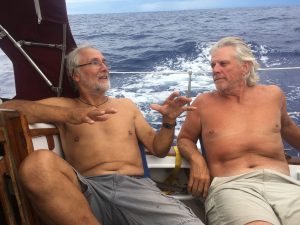 After rooting around in the fridge I was able to come up with smoked salmon, cream cheese, capers, shallots & lemon on the last bits of bread for toast. I decided to make more bread again, but didn’t have quite as good results. Our oven takes forever to heat up (bad gaskets) and I hadn’t factored the heat and humidity, so the loaf was over proofed by the time I put it in to bake. Not as pretty looking as the first loaf but it did still taste good.
After rooting around in the fridge I was able to come up with smoked salmon, cream cheese, capers, shallots & lemon on the last bits of bread for toast. I decided to make more bread again, but didn’t have quite as good results. Our oven takes forever to heat up (bad gaskets) and I hadn’t factored the heat and humidity, so the loaf was over proofed by the time I put it in to bake. Not as pretty looking as the first loaf but it did still taste good.
After several days of no company we finally saw two sailboats on the horizon. We spoke to one who mocked us for our speed (2 knots? That’s not drifting). I had my brother look him up and it turns out he was the captain of a boat that had hit the rocks up in Cape Cod in 2013. We went back to drifting while they motored with unlimited fuel to some fabulous yacht club in St Thomas. Lyle started making plans to confront the douchebag if we ever came across him in the islands.
Dinner: tomato and red pepper soup with rice with grilled cheese sandwiches, oatmeal chocolate chip cookies
Day 9
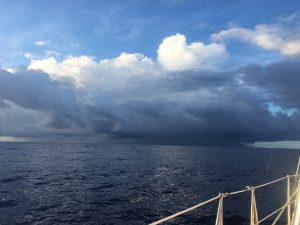
Squalls to the left
We started the day dodging squalls and feasting on the last of the bread as French toast. The winds were growing, but unfortunately coming out of the south. We had run through our fuel, with the exception of what we were holding in reserve to charge the batteries and motor into harbor.
I texted my brother Chad on the InReach and asked him to start sending trivia questions. He comes through in stellar form and the boredom on board is alleviated.
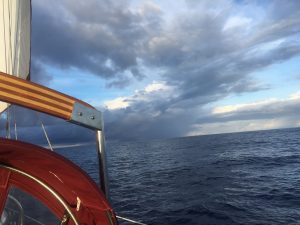
Squalls to the right
Dinner: leftover jambalaya with more johnny cakes
Day 10
It was only a matter of time before we hit the squalls. We’ve been running parallel to lightning storms for hours on end but none have crossed over to us, and there’s no sign of thunder which indicates they’re pretty far out. We’ve developed a pretty good system for reefing and we’ve become pretty efficient as a team at getting sail changes in place as the weather sours. We declare the trade winds (supposedly steady 10-15 knots from the east) traitorous winds, but at least we’re able to move south (albeit southeast or southwest) at 5 knots under a double reefed main and reefed jib.
There’s no way we’re going to make this trip in any of the forecasted time of 9-10 days. 12-14 is far more likely now. With the winds or lack thereof and our inability to sail well into the wind, it’s going to be a long slog. At least we have plenty of food and trivia questions.
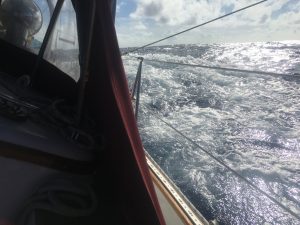 Using the InReach we asked Christine to rebook Lyle’s flight. We forgot that we’re getting in the week before Thanksgiving (early this year), so flights are at a premium. At least we have the InReach to communicate.
Using the InReach we asked Christine to rebook Lyle’s flight. We forgot that we’re getting in the week before Thanksgiving (early this year), so flights are at a premium. At least we have the InReach to communicate.
The shooting starts are at least still with us at night so there’s still a comforting factor.
Dinner: chicken tetrazzini
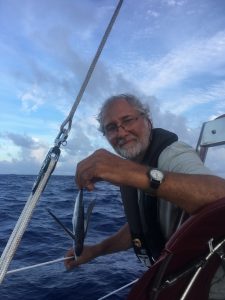
Flying fish
Days 11-13
The big winds hit and they bring confused seas. I’m done cooking for a few days so it’s sandwiches and soup to keep the crew going. Even that is a bit of a challenge bracing myself to fix meals.
We’re down to the 500 mile mark but it doesn’t feel like it – still a long way to go. Lawrence’s seasickness, which we thought was a thing of the past, comes back with a vengeance. We move into three hour watch rotations since none of us seem to be sleeping for more than 2 hours at a time.
We do finally see more boats on the AIS and talk with Taiko, one of the boats from the ARC 1500 rally going to Tortola. Because there’s essentially no one for miles around we chat for quite some time on channel 16. It’s fun to hear other voices heading in the same direction. Dinner: sandwiches (much too rough to cook)
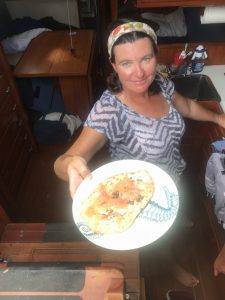
Galley work
The seas are a little bit more comfortable the next morning, so I break out a watermelon which I had been saving. Lawrence still isn’t feeling well, but the watermelon does a lot to start to revive him.
We’ve been running squalls all night and I’ve found out the hard way that my foul weather gear (now 10 years old) is not waterproof anymore. We’re soaked to the bone.
400 miles to go. Dinner: soup (too rough for much else)
And then Lawrence is finally on the mend again as his scopolamine patch kicks in – Lyle’s little buddy ‘Patch’ is back in the game. 300 miles to go. Dinner: soup again
Days 14-17
WTF!…….. what happened to the consistent trade winds that we could ride down to the islands? The wind is consistently coming from exactly the direction we need to go. Tacking is doable but we cover half the distance as the crow flies that we need to now.
I’ve begun texting James on the InReach for marine forecasts – I don’t know why we didn’t think of doing this sooner rather that Trip trying to listen into the SSB forecasts and hoping to catch the right quadrant.
No surprise – more squalls with really heavy rain. The evenings are a little creepy when there’s no stars, no moon, and all you can try to do is feel squalls as they approach. We do have a sense of humor though – the new crew song is Escape (the pina colada song) which we sing at full volume as each new squall begins to build. Dinner: kielbasa and sweet potato/potato hash
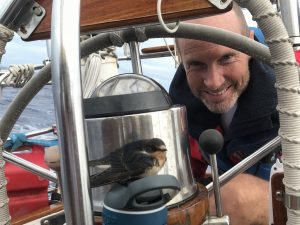
Lawrence & Contigo
Good weather was finally facing us in the morning, along with a huge pod of dolphins swimming along side of us. A number of them are leaping out of the water and one so high we could see the pink/purple of his underbelly. We also had another visitor – a little bird swooped in and settled right on Lawrence’s water bottle for an hour or so. I’ve never seen an animal so small show no fear, he just sat there while we ogled and took pictures. Lawrence named him Contigo after the water bottle and he left shortly thereafter.
We had mimosas to celebrate crossing over into the 20th latitude. The countdown has begun. Bread didn’t seem like a good option in still lumpy seas but pita bread was perfectly easy to make. I had bit of smoked salmon leftover so we did open faced sandwiches again.
We were wrong about the signs for good weather, by the way. They were more like little hints that it was going to be a long slog and we’d better buckle up. Funny how the human brain rationalizes things at the time.
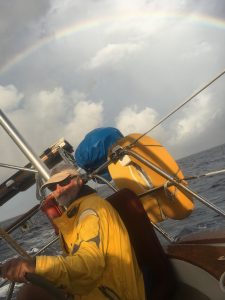
At least some squalls bring rainbows
We crossed paths with a French Canadian boat called Zen Lattitude and spent some time chatting on the radio with them. They were kind enough to radio us later that night with the warning of a northeastern squall moving in in the middle of the night. We had all of 2 minutes to get some reefs in before that one hit and we were more than grateful for the advance warning. Dinner: pesto tortellini
Kicked off the day with breakfast burritos – a new crew favorite. Things are really starting to get frustrating now – are we ever going to get there?
One particularly big squall tonight – Lyle just held on to the wheel and went for a ride as the wind climbed. We’ll never know what speed it hit – 50 knots?
I text Viviane on the Inreach and ask her to call BoatUS to see if they have operations in the USVI (marine version of AAA) and if they would deliver fuel. The answer is a resounding yes, but we’re 50 miles out and we need to be within 25 miles. We manage to cover 25 miles under sail that night, getting us into range.
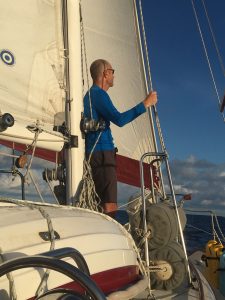
Are we there yet?
We’re now drifting, nowhere near getting any closer to the island (though clearly in sight) and the forecast is for more southerlies for the next several days.
We’ve eaten the last of the potato chips and bacon and drunk the last of the beer, it’s time to contact Boat US. Unfortunately they’re still using the coordinates from the night before so someone now feels obligated to call the Coast Guard. I’m getting messages instructing us to activate our EPIRB (emergency beacon) which is ridiculous. Lawrence gets a hold of the Puerto Rico Coast Guard and explains that there is no distress whatsoever. They acknowledge and offer to relay info to the Boat US captain.
When Boat US shows up they insist they didn’t get any message about fuel and instead are there to tow us in. We have a decision to make. It seems a rather discouraging moment to sail over 1400 miles and have to get towed in the last 12 miles, but it was possibly going to be days before we could get in on our own. (In retrospect I’m sure the skipper gets paid more for a tow than a fuel delivery so he was probably behind the ‘miscommunication’). We hook up the bridle and settle in for the ride to Red Hook.
We pass through one of the most violent thunderstorms under tow – there were three distinct bolts of lightning and claps of thunder that physically shook the boat. It was raining so hard I’m not sure anyone even noticed us coming in under tow.
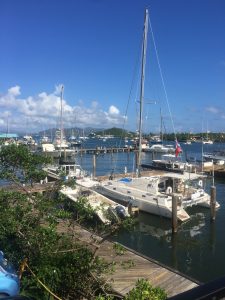
Red Hook, St Thomas
At last, dry land again.
In retrospect, it was the voyage of a lifetime. Frustrating at times when the winds wouldn’t cooperate and uncomfortable at others in confused seas or hard on it or in the middle of a squall, but never in a situation where I felt both the boat and the crew couldn’t get through. Friendships that are cemented for life, knowing that it will be so difficult to explain to others what it was like out there together. Mind blowing things that we began to take for granted, like the brilliant moon, star studded skies (too many shooting stars to count after a while), flying fish, dolphins, birds. The color of the sea as we passed through the deep indigo of the gulf stream into the carribbean blue.
And this is just the beginning.
Special thanks to three people who have been declared honorary crew:
– Viviane (Lawrence’s wife): for her daily fun checkins and all of her help once we decided to contact Boat US.
– Chad (my brother): for his updates on news of the day and trivia that provided many a needed distraction during the moments of boredom.
– James: our new offshore meteorologist. He may not have delivered good news, but the forecasts were always timely and much appreciated.
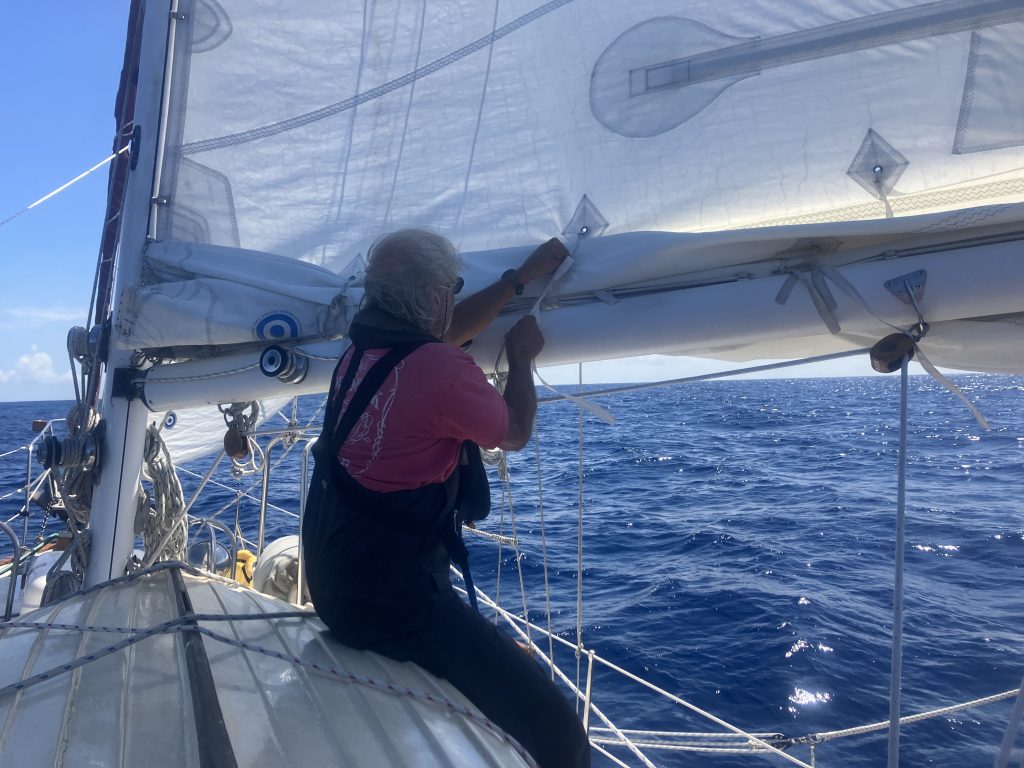
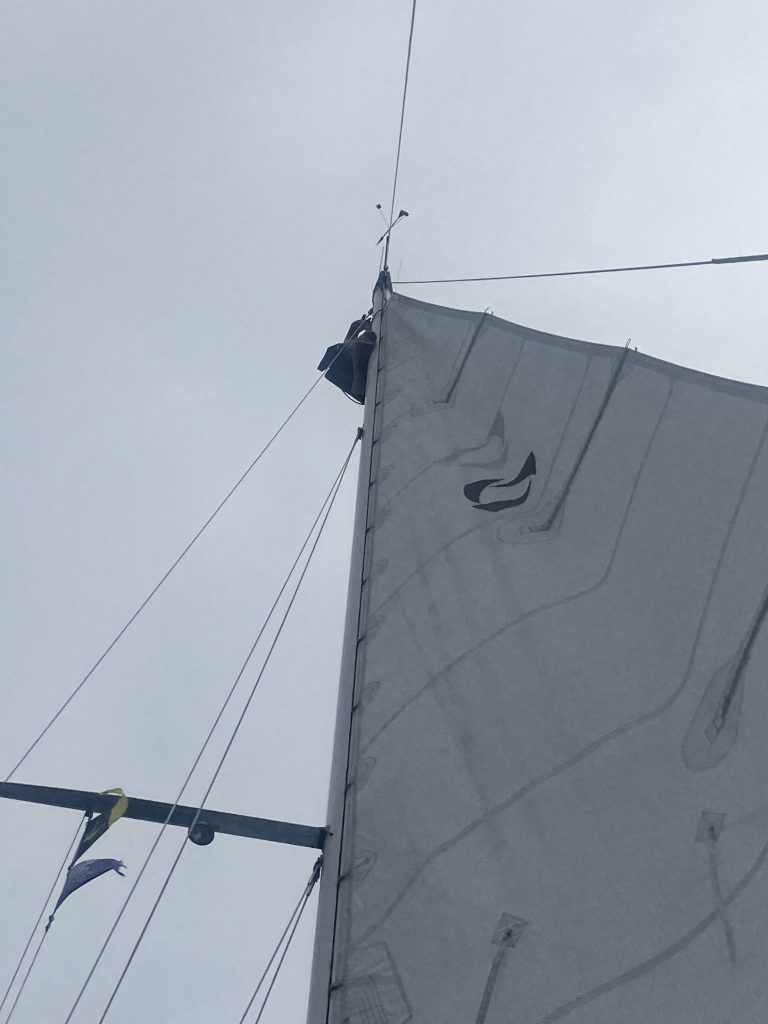
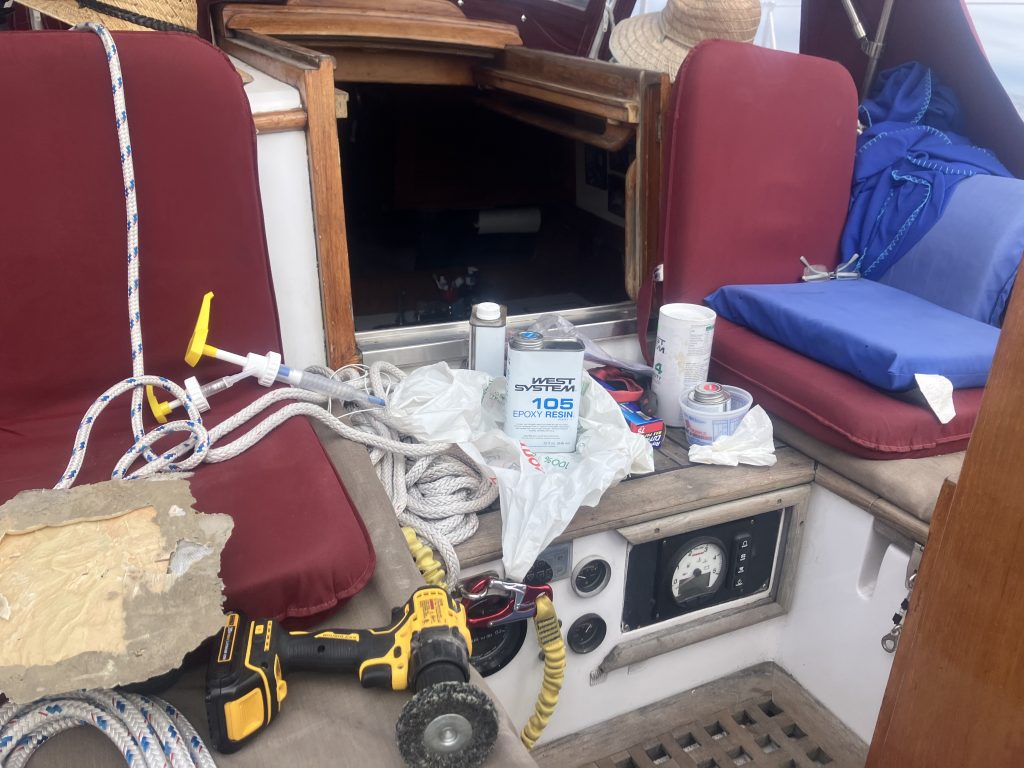
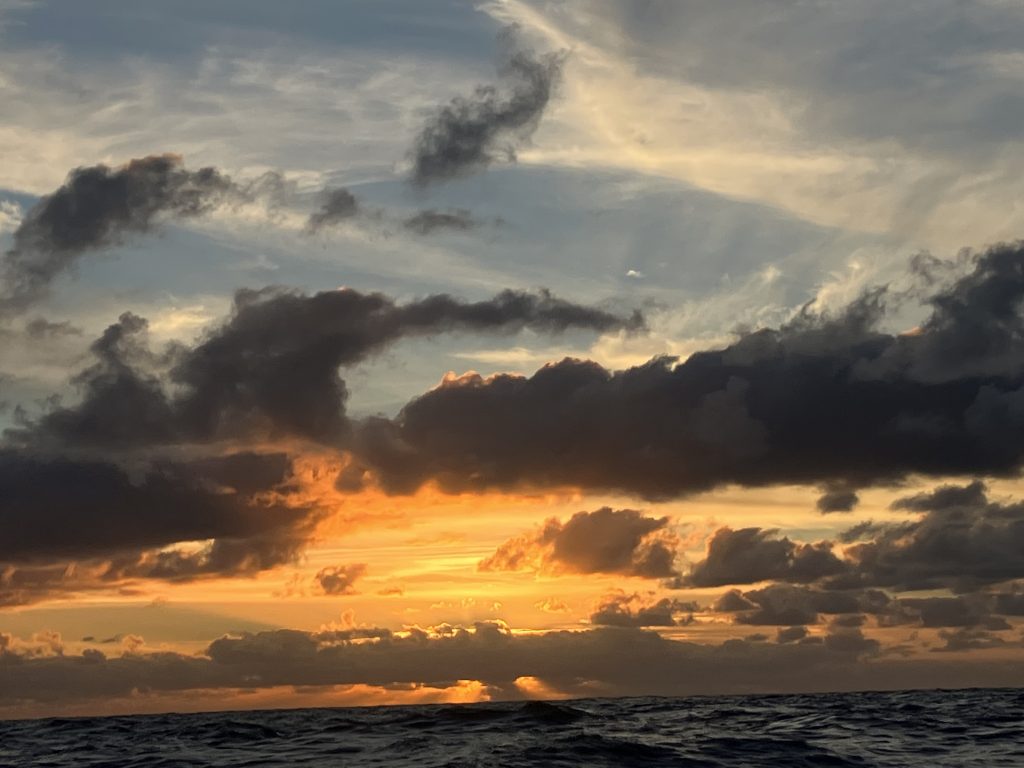
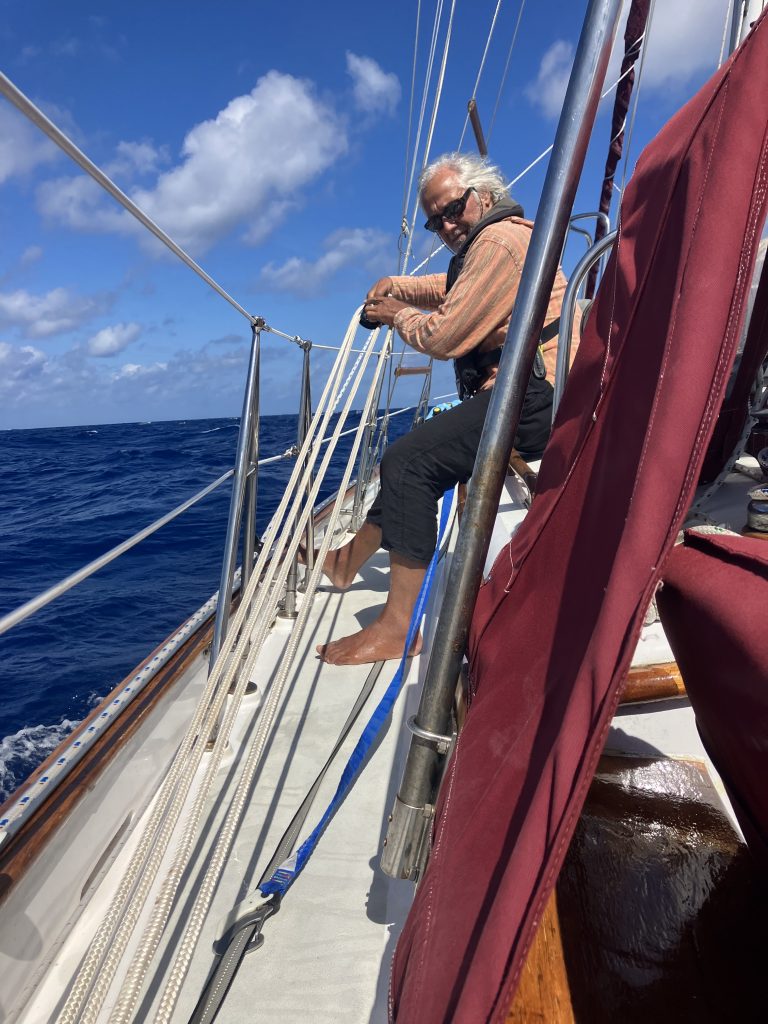
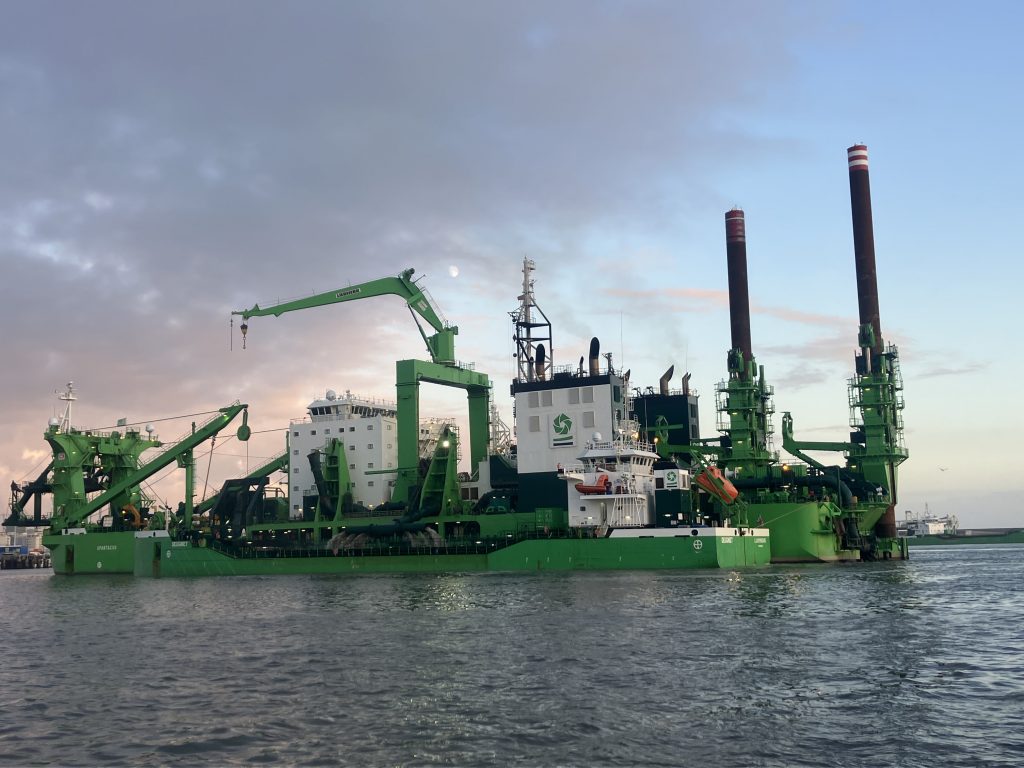

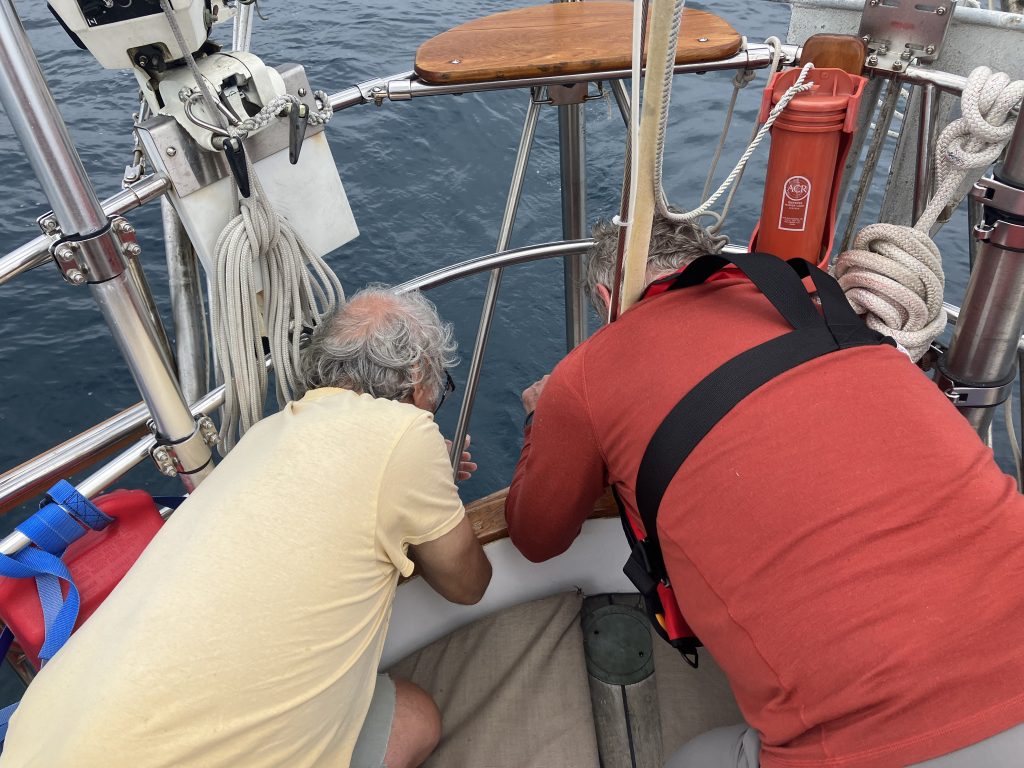
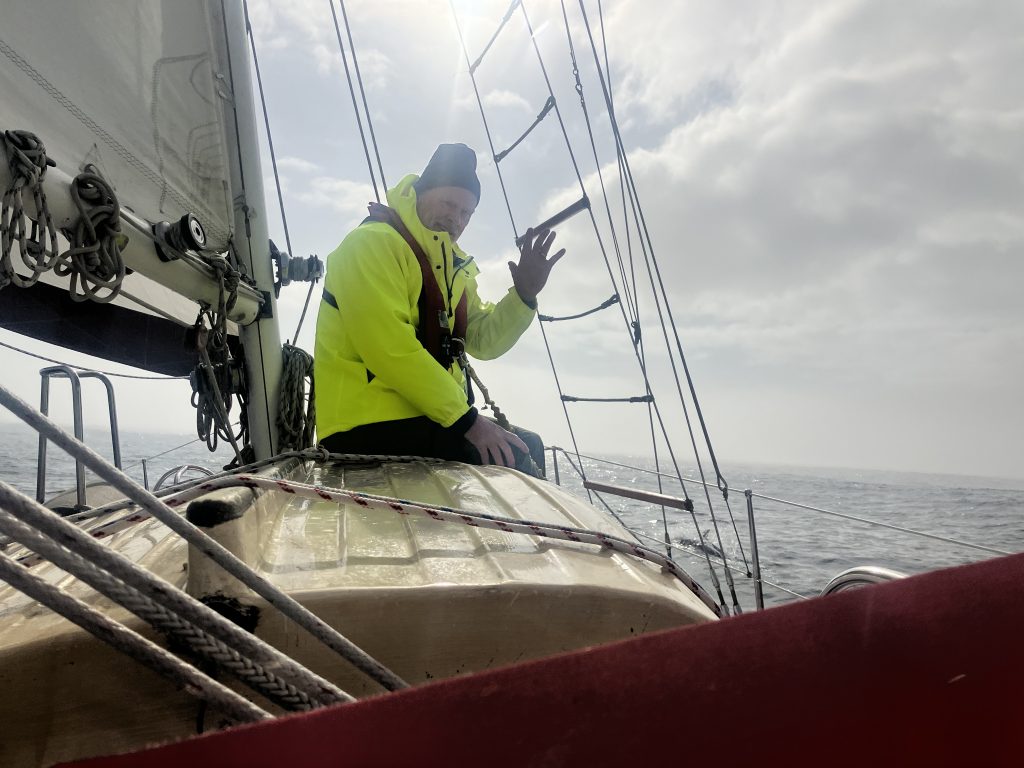
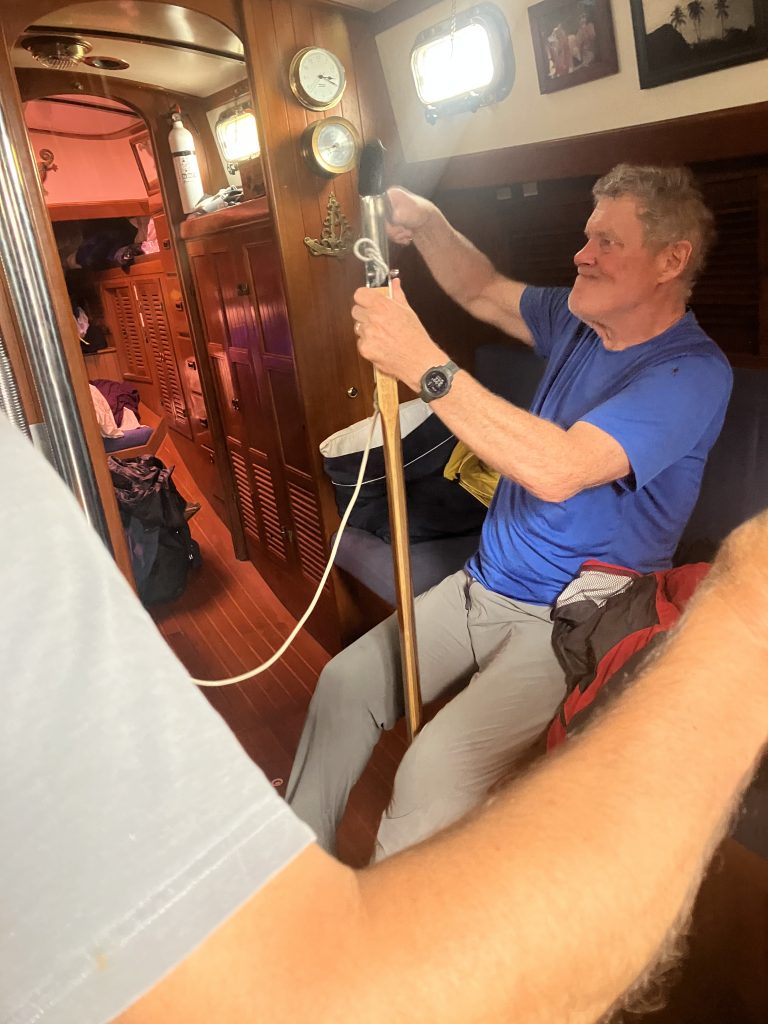
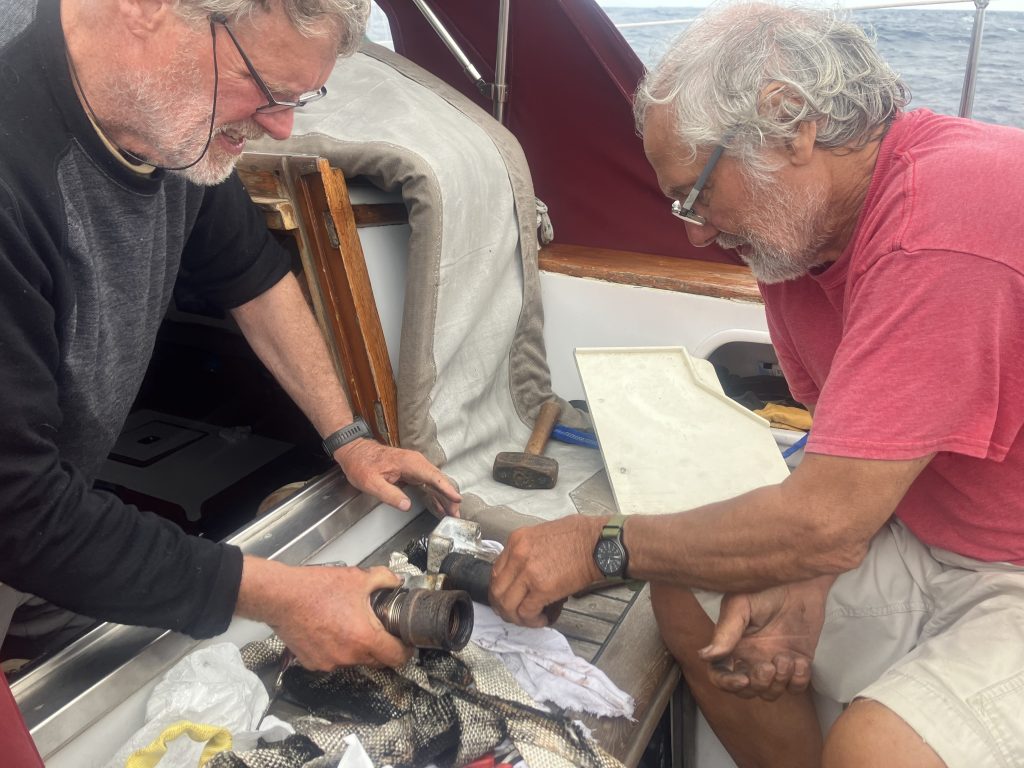
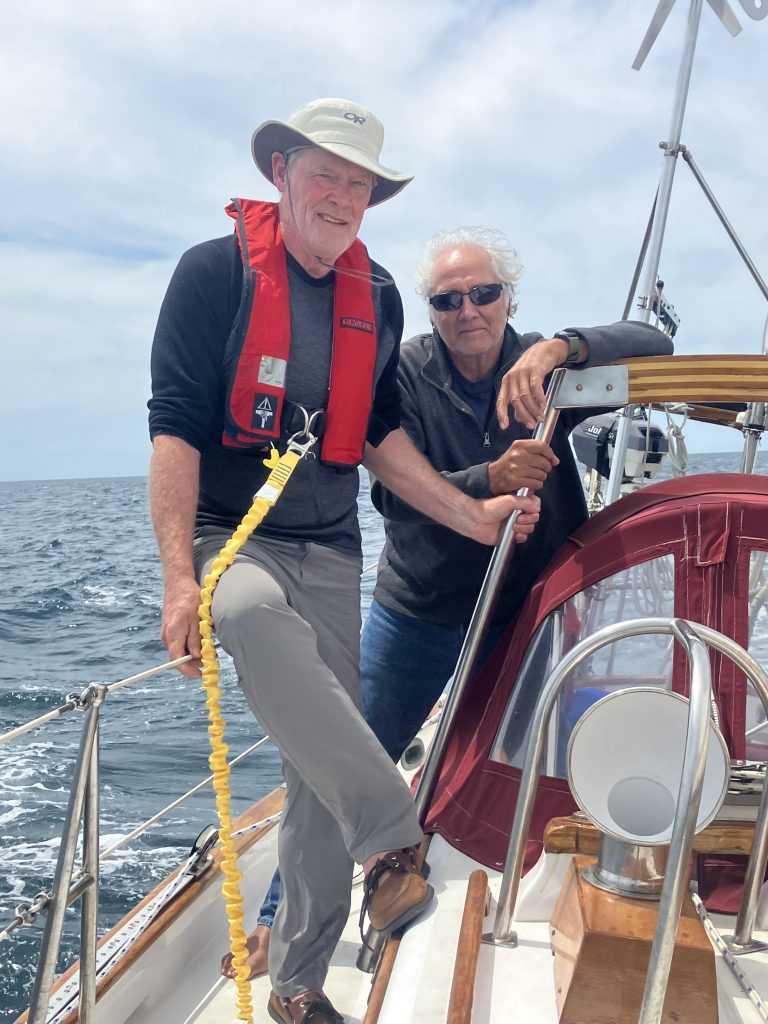
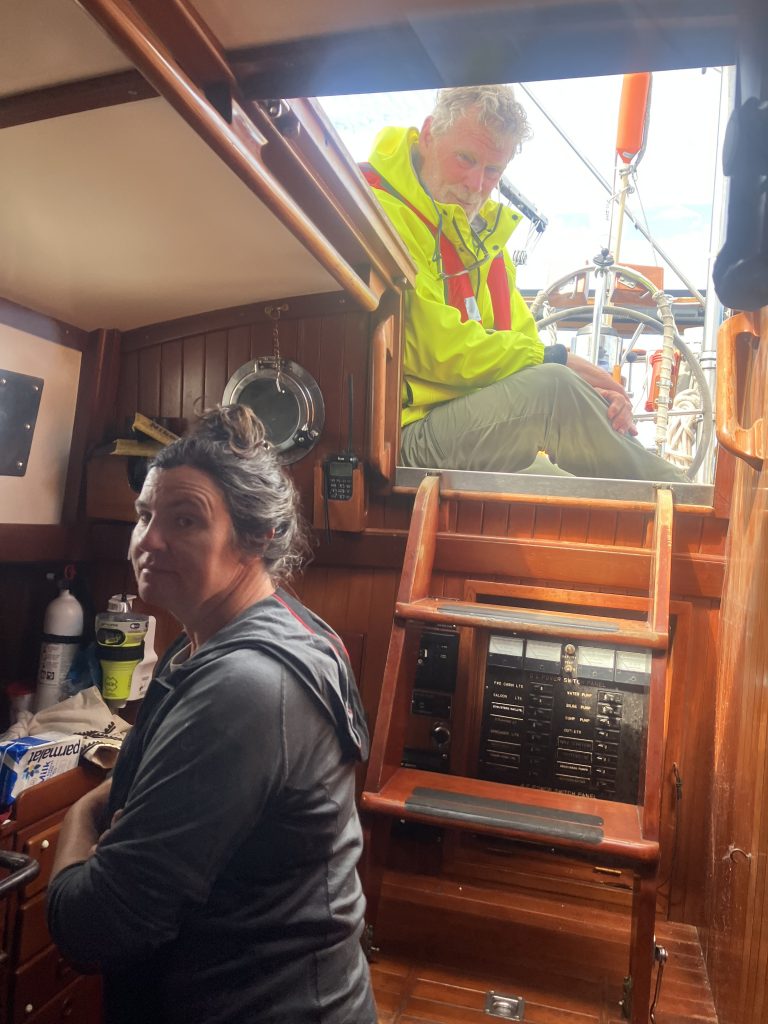
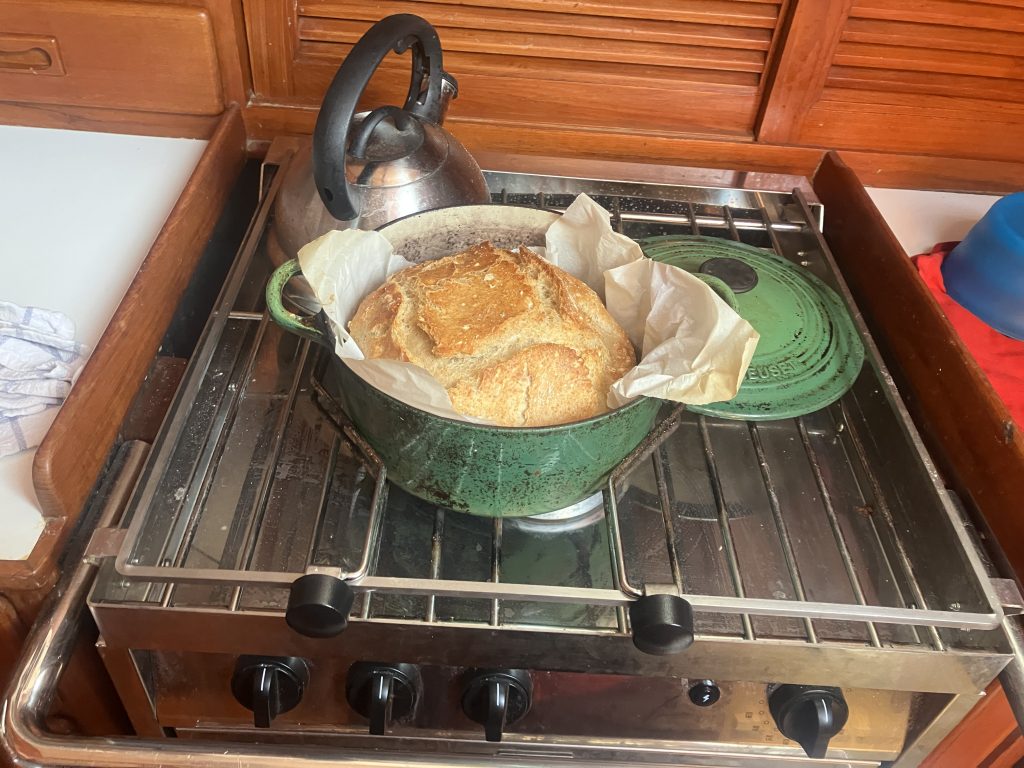
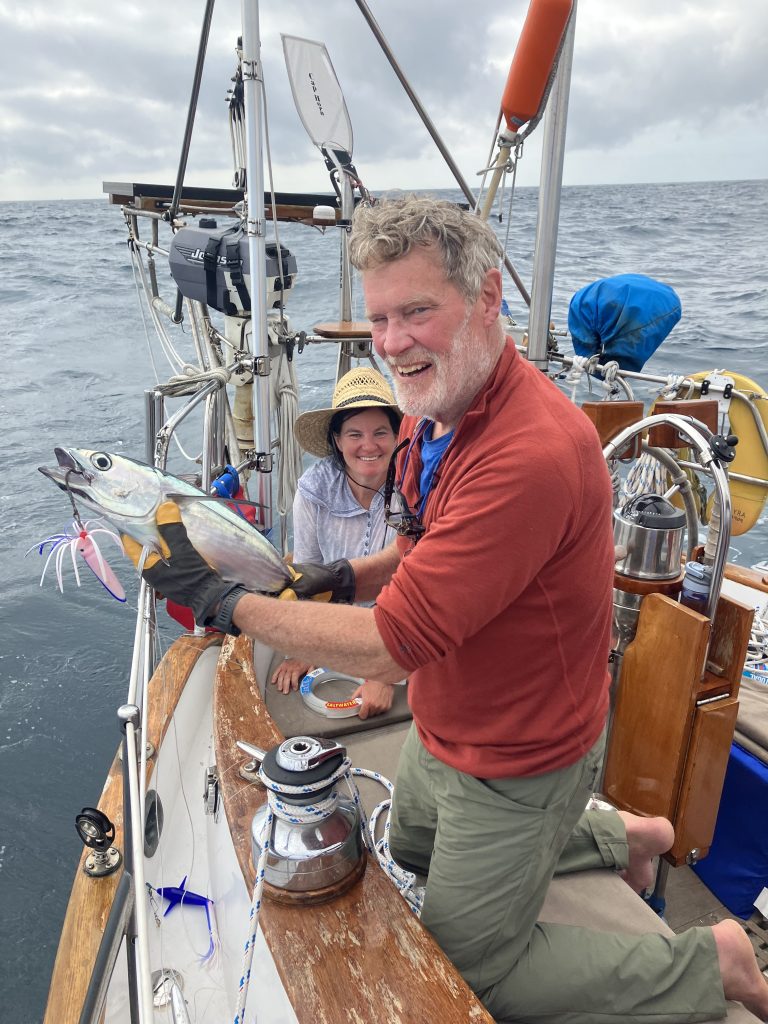
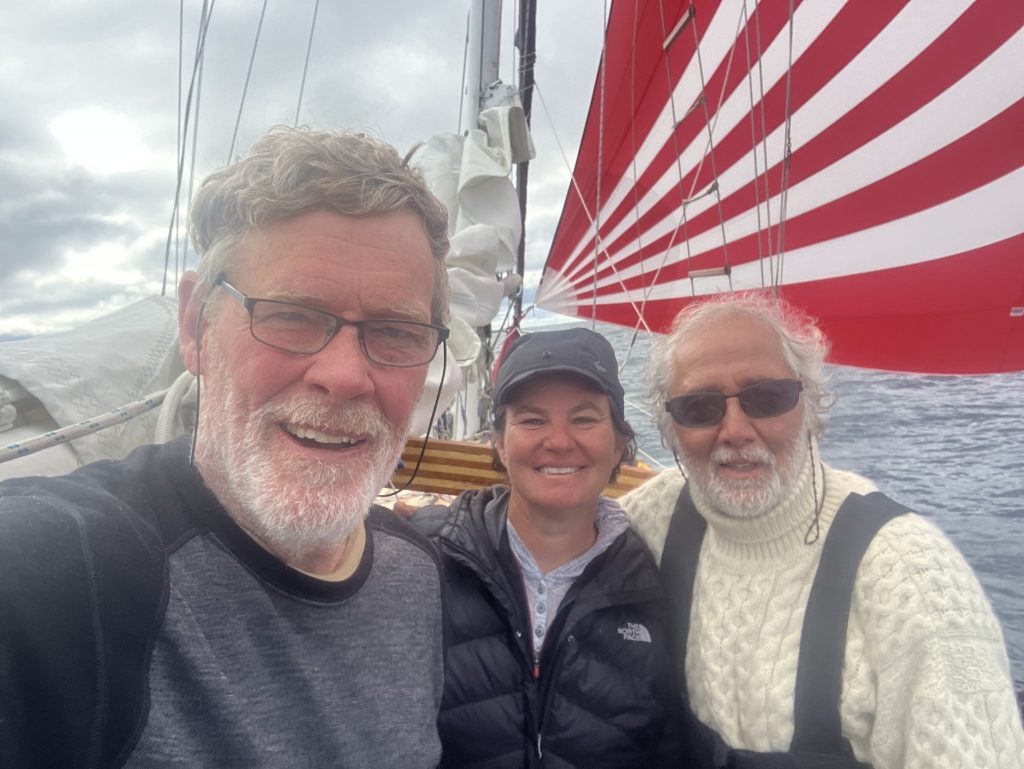
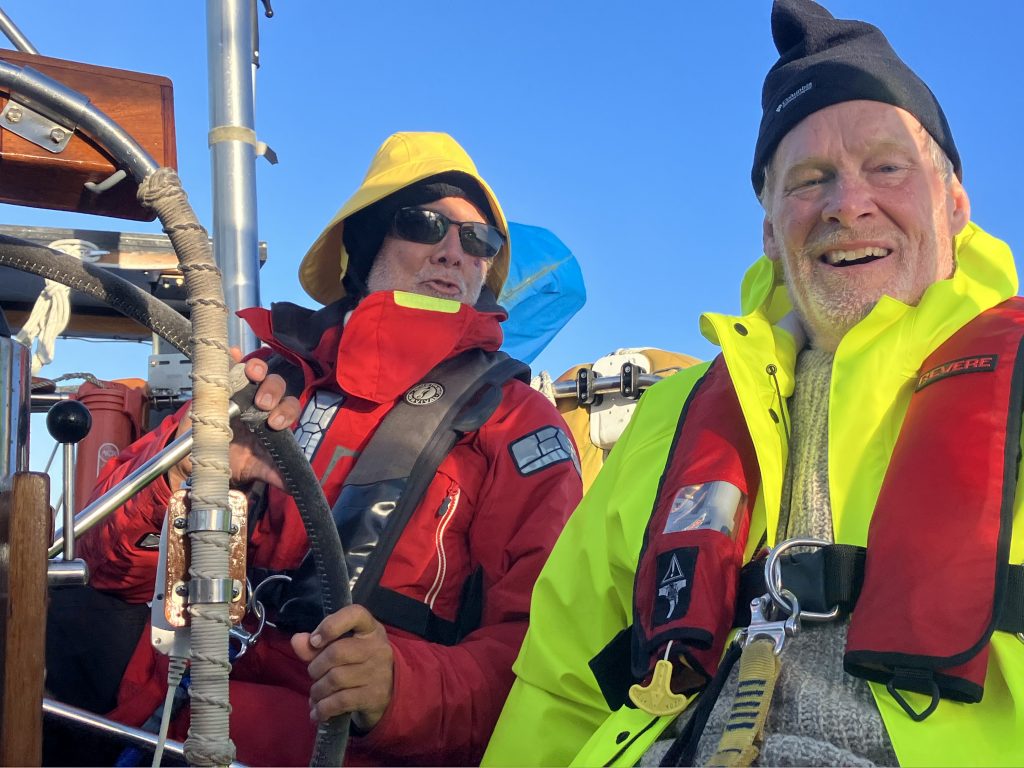
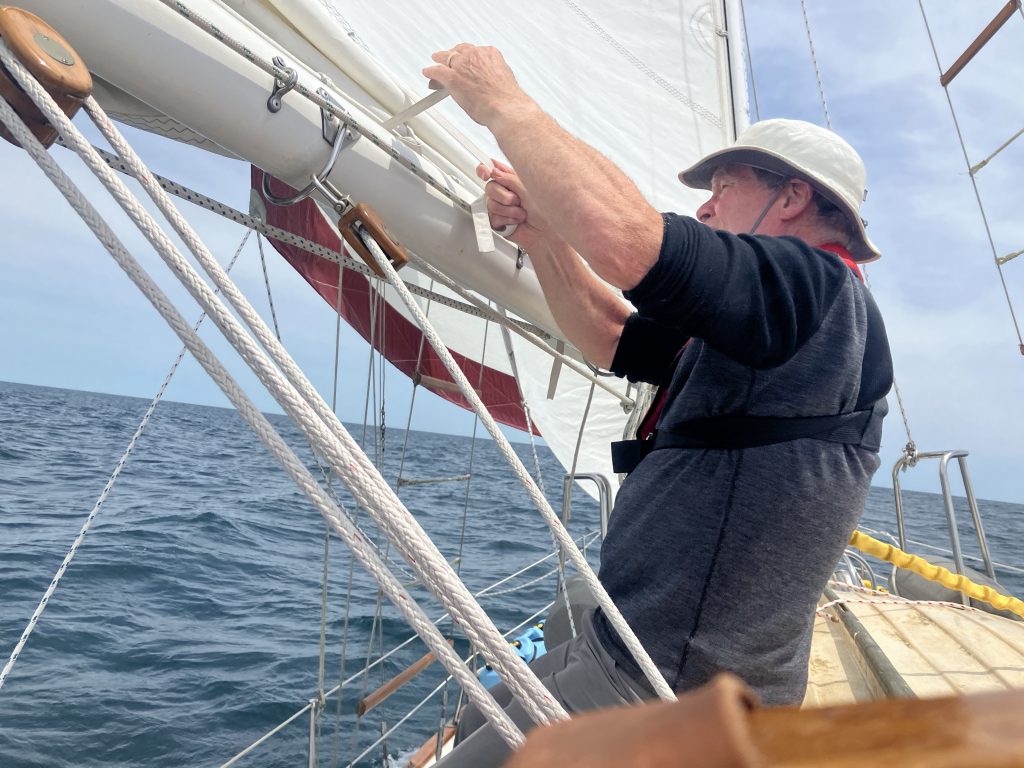
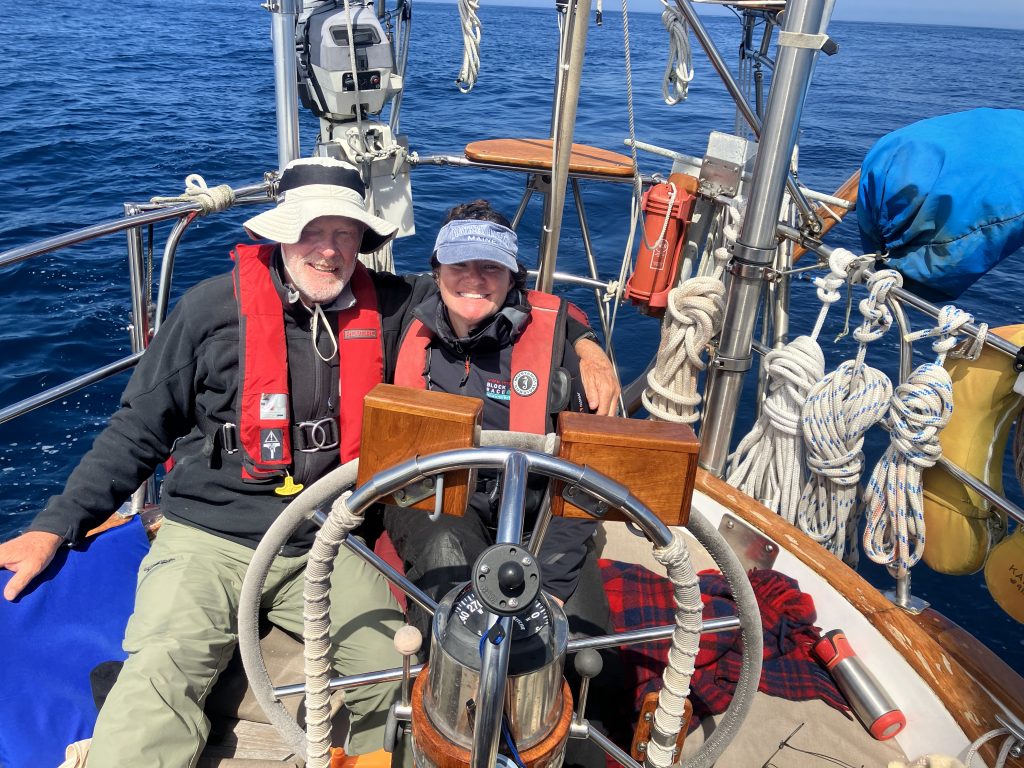
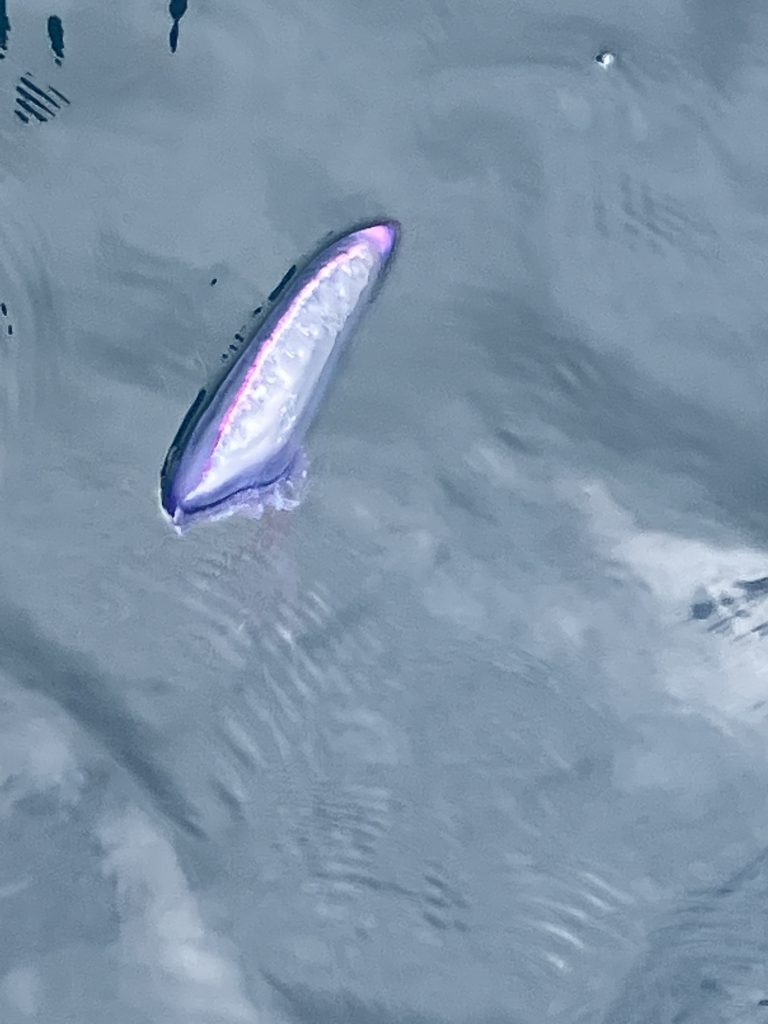
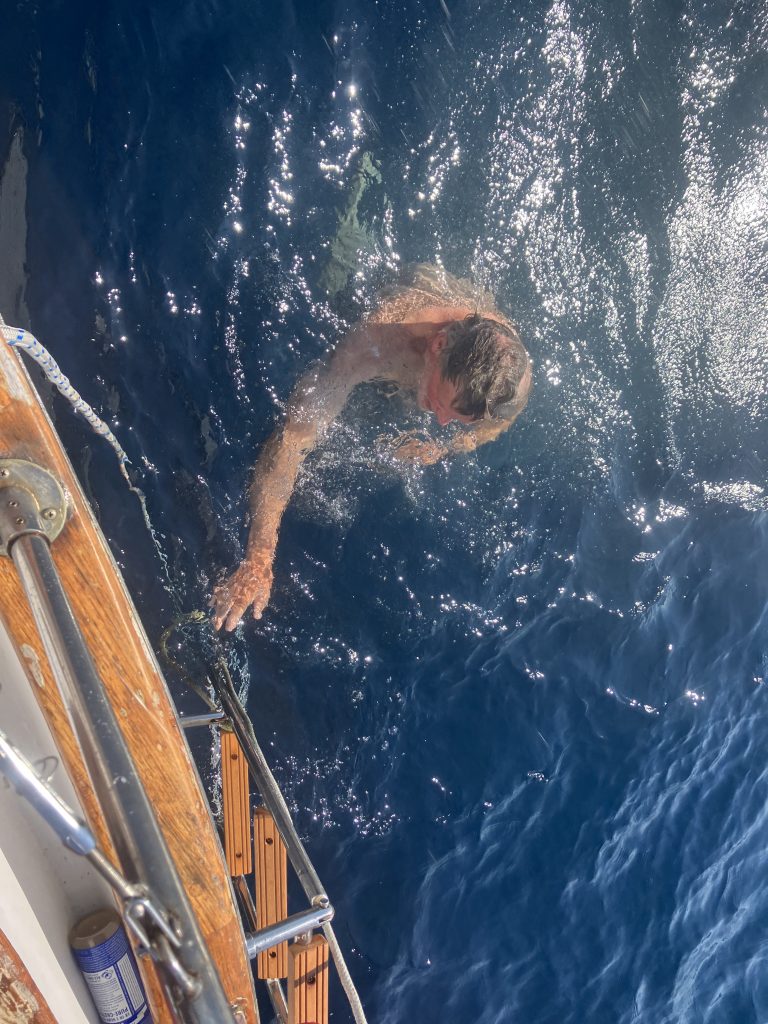
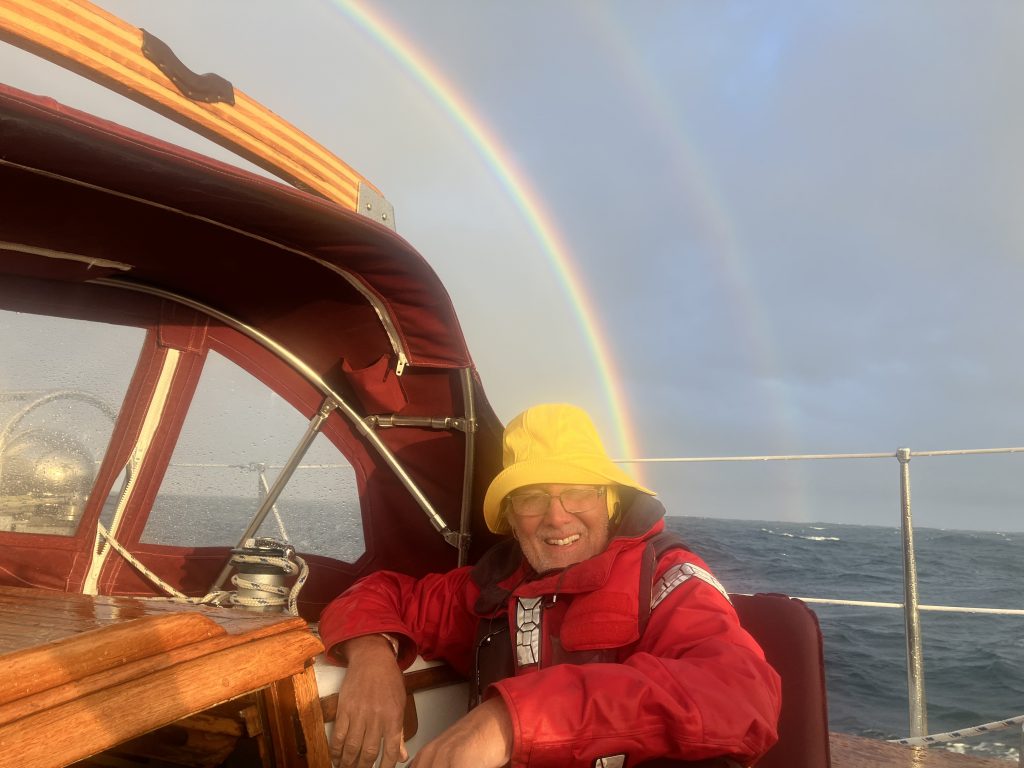
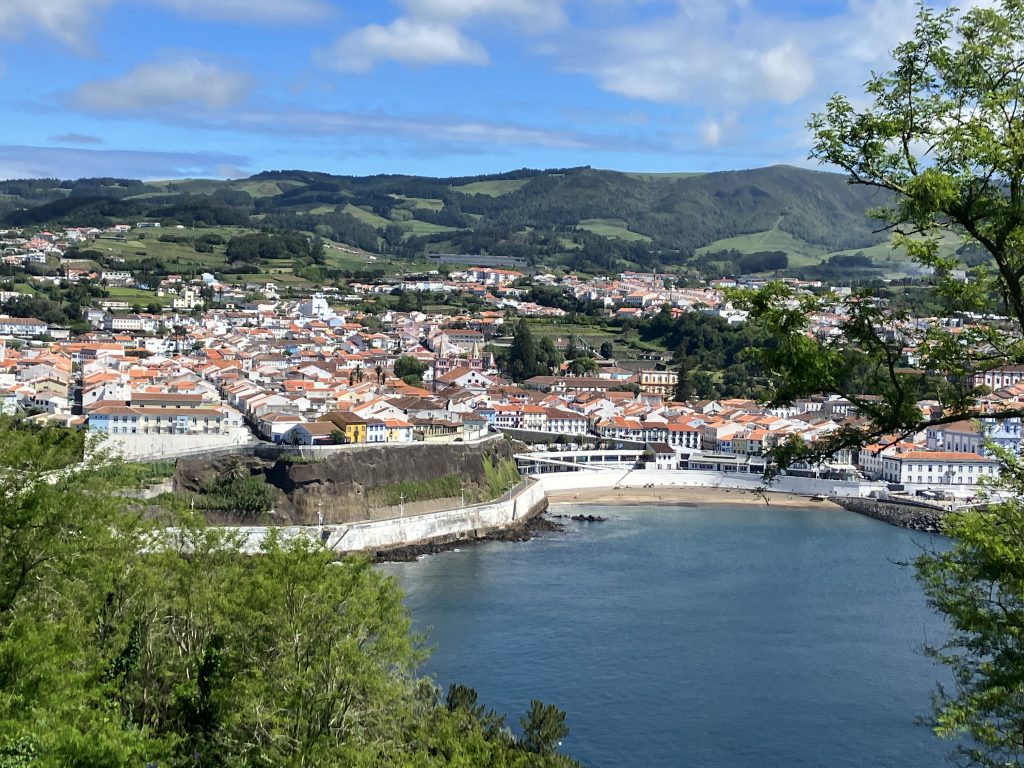



 One plus side to the trip is that Trip is finally letting us use the auto helm. Normally a stickler for steering by hand, we started using it more this summer when we were motoring. I started using it for everything on this sail and he hasn’t protested.
One plus side to the trip is that Trip is finally letting us use the auto helm. Normally a stickler for steering by hand, we started using it more this summer when we were motoring. I started using it for everything on this sail and he hasn’t protested.



 After rooting around in the fridge I was able to come up with smoked salmon, cream cheese, capers, shallots & lemon on the last bits of bread for toast. I decided to make more bread again, but didn’t have quite as good results. Our oven takes forever to heat up (bad gaskets) and I hadn’t factored the heat and humidity, so the loaf was over proofed by the time I put it in to bake. Not as pretty looking as the first loaf but it did still taste good.
After rooting around in the fridge I was able to come up with smoked salmon, cream cheese, capers, shallots & lemon on the last bits of bread for toast. I decided to make more bread again, but didn’t have quite as good results. Our oven takes forever to heat up (bad gaskets) and I hadn’t factored the heat and humidity, so the loaf was over proofed by the time I put it in to bake. Not as pretty looking as the first loaf but it did still taste good.

 Using the InReach we asked Christine to rebook Lyle’s flight. We forgot that we’re getting in the week before Thanksgiving (early this year), so flights are at a premium. At least we have the InReach to communicate.
Using the InReach we asked Christine to rebook Lyle’s flight. We forgot that we’re getting in the week before Thanksgiving (early this year), so flights are at a premium. At least we have the InReach to communicate.





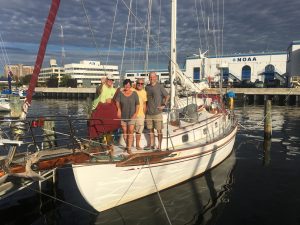
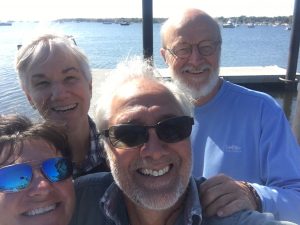
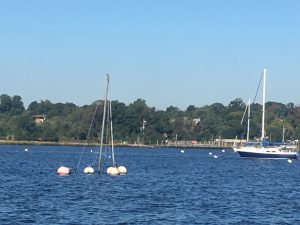
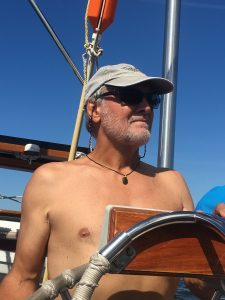
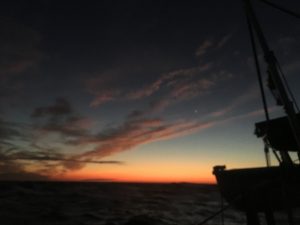
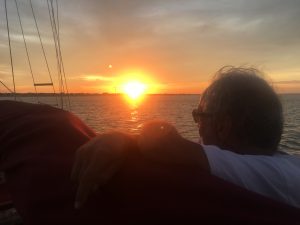
Recent Comments